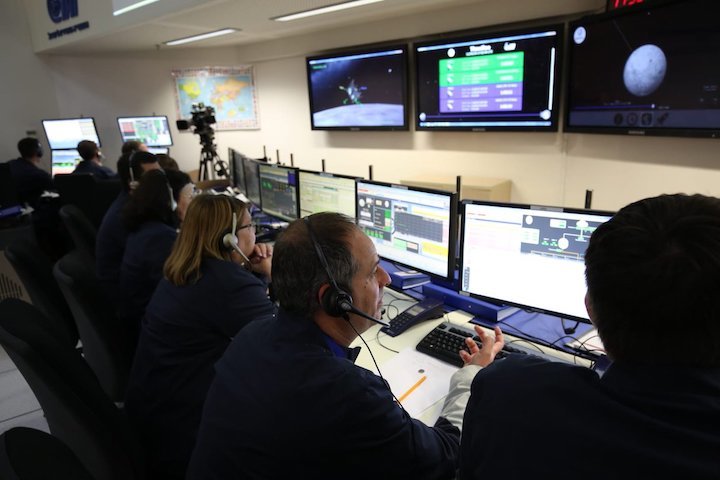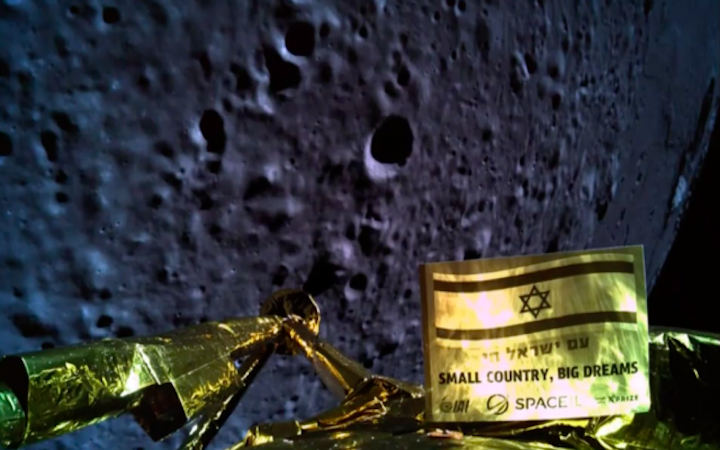Former astronaut and second man on the moon Buzz Aldrin on Thursday tweeted his condolences to the team behind the Beresheet spacecraft which crashed into the moon’s surface during its landing attempt on Thursday evening, saying the project was “inspiring.”
“Condolences to the Beresheet lander @TeamSpaceIL for what almost was! Communications were lost with the spacecraft just 150 meters (!!!) above the surface, and it couldn’t quite stick the landing. Never lose hope – your hard work, team work, and innovation is inspiring to all!” tweeted Aldrin, who was a member of the US Apollo 11 mission to the moon in 1969.
Israel could still claim the title of seventh country to make lunar orbit, and the fourth country to reach the lunar surface, though unfortunately not in one piece.
“As far as we can see, we were very close to the moon,” operation control director Alex Friedman said to engineers in the SpaceIL control room in Yehud, east of Tel Aviv, after communication with the spacecraft went down. “We are on the moon, but not in the way that we wanted to be.”

The project launched as Israel’s entry into the Google LunarX challenge for nongovernmental groups to land a spacecraft on the moon. Google ended the contest in 2018 with no winners, but the Israeli team decided to continue its efforts privately.
LunarX announced Friday that it would award the Israeli team a $1 million moonshot XPrize in honor of their achievements.
“We’re extraordinarily proud they made it this far,” said Peter Diamandis, XPrize founder.
The head of NASA, Jim Bridenstine, said he regretted the mission didn’t succeed, but said he had “no doubt that Israel and SpaceIL will continue to explore and I look forward to celebrating their future achievements.”
President Reuven Rivlin hosted dozens of youngsters at his official residence, one of several celebrations scheduled across the country.
“We are full of admiration for the wonderful people who brought the spacecraft to the moon,” Rivlin said. “True, not as we had hoped, but we will succeed eventually.”

The spacecraft successfully initiated the landing sequence, but a few kilometers above the moon’s surface the main engine failed, meaning the spacecraft could not properly brake in time to cushion its landing.
“Write this down: In three years we will get another spacecraft on the moon, and this one will land in one piece,” said Prime Minister Benjamin Netanyahu.
“If at first you don’t succeed, try again. We’ll try again, and next time we’ll just try it more gently.”
Phil Larson of the University of Colorado, who was a space adviser in the Obama White House, said the Israeli effort underlines that “space is still extremely hard, and landing human-made objects on other worlds is an utmost challenge.”
But, he added, “While it failed to land successfully, overall it was a path-breaking and innovative project.”
The spacecraft was budgeted at $100 million (NIS 370 million), a fraction of the cost of vehicles launched to the moon by major powers US, Russia and China in the past. It was a joint venture between private companies SpaceIL and Israel Aerospace Industries, funded almost entirely by private donations from well-known Jewish philanthropists, including South African billionaire Morris Kahn, Miriam and Sheldon Adelson, Lynn Schusterman, and others.
“Space is hard,” said Ehud Hayun, a space systems engineer at Israel Aerospace Industries. “I’m not crushed, I’m disappointed, but I’m very proud of what we achieved. We had a lot of success along the way, until the hard landing. We knew it was a risky mission, and the risk we were taking to build it cheap and fast. But we tried.”
SpaceIL co-founder Yariv Bash said it would take about two or three years to get another prototype ready for a moon landing. Netanyahu asked philanthropist Kahn to fund it again, though Kahn expressed hope that a second run would cost a little less.
Opher Doron, the general manager of the Space Division at Israel Aerospace Industries, said engineers were still studying the problem that led to the crash. Current thinking is that there was a failure with one of the telemetry (altitude) measurement units, which caused a chain of events culminating in the main engine cutting out about 10 kilometers (6 miles) above the moon’s surface. Without the main engine, the spacecraft could not properly brake in time to make a gentle landing, rather crashing onto the surface.
The three SpaceIL co-founders, who initially decided to participate in the GoogleX Lunar Prize contest some eight years ago, said they would continue their mission of space education and encouraging children to enter science fields.

“I want to turn to kids that might be watching us,” Yonatan Winetraub said in a press conference after the crash. “We didn’t reach the moon in one piece. That sucks. However, engineering and science are hard. Sometimes it doesn’t work the first time, sometimes it doesn’t work the second or third time. But it will work.”
“I want to encourage you to continue studying these things so you can one day reach the moon, and the stars,” he added.
“This is not what we were hoping for, but I think in the last few years we made history,” said Kfir Damari.
“We got Israel to places we couldn’t have imagined before. It was a long journey. We got Israel to the moon, together, this whole team. Now it’s the kids’ job to continue to build future spacecraft to reach the moon.”
“This is what happens, this is space,” said Morris Kahn. “Space has its dangers, it’s a frontier that’s very difficult. We accepted the challenge. I’m glad we did it. We chose to dream, we chose to do, and we were not afraid.”
“We are still the seventh country to get to the moon,” said Winetraub. “And that is still pretty incredible.”
Quelle: The Times of Israel
+++
We have not managed to land successfully’: Israel's moonshot fails
Spacecraft crashes in to lunar surface after engine and communications breakdown

An Israeli spacecraft has crashed into the lunar surface, ending the first privately funded attempt to land on the moon.
About the size of a washing machine, the 585kg (1,290lb) robotic lander experienced an engine and communication failure in the last seconds of touchdown.
The mission ended Israel’s hopes of joining the ranks of Russia, the US and China as the only countries to have made controlled landings on Earth’s nearest neighbour.
“We had a failure in the spacecraft. We unfortunately have not managed to land successfully,” said Opher Doron, the general manager of IsraelAerospace Industries’ space division.
“It’s a tremendous achievement up to now,” he added, saying the probe had already made Israel the seventh country to orbit the moon and the fourth to reach the lunar surface.
Named Beresheet, the Hebrew word for genesis, the four-legged craft had intended to measure magnetic fields from its landing site on a lunar plain called Mare Serenitatis, the Sea of Serenity.
Its frame held a time capsule of digital files the size of coins containing the Torah, children’s drawings, dictionaries in 27 languages, Israeli songs, as well as memories of a Holocaust survivor.
Beresheet was launched in February aboard a Falcon 9 rocket, one of SpaceX’s private fleets run by the billionaire entrepreneur Elon Musk.
While crewed lunar trips have taken around three days, the probe took a much more circuitous route for its four million-mile (6.5m km) journey. It has spent 47 days, gradually making ever-widening elliptical orbits around the Earth until it was “captured” by the moon’s gravitational pull and looped closer to its surface.
On Wednesday, the lander made a manoeuvre to lower its altitude for a lunar orbit of between nine and 124 miles while preparing for the landing. It managed to take a photo of the moon minutes before communication was lost.
Funded almost entirely by donations, Beresheet was built by SpaceIL, an Israeli non-profit set up for the mission, in partnership with the state-owned Israel Aerospace Industries. It cost about £70m, a fraction of the cost of previous state-led missions.
Morris Kahn, a South African-born Israeli billionaire, is the main backer but the US Republican party and pro-Israel funder Miriam Adelson and her casino-owning husband, Sheldon, also gave $24m.
Israel’s prime minister, Benjamin Netanyahu, who was at mission control, said: “If at first you don’t succeed, try again.”
US and European space agencies intend to use an expanding commercial space industry to send people back to the moon. A Nasa-led plan is already underway to build a small crewed space station orbiting the moon, and the private sector has been tasked with helping to build it.
Russia was the first country to make a soft landing, rather than a plummeting crash, on the surface of the moon in 1966. Following the end of the space race in the 1970s, there was no return until China sent a lander in 2013. In January this year, Beijing made history by landing a spacecraft on the far side of the moon.




